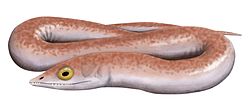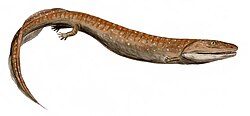| Brittagnathus Temporal range: | |
|---|---|
 | |
| Holotype of B. minutus | |
| Scientific classification | |
| Kingdom: | Animalia |
| Phylum: | Chordata |
| Clade: | Stegocephali |
| Genus: | † Brittagnathus Ahlberg & Clack, 2020 |
| Species: | †B. minutus |
| Binomial name | |
| †Brittagnathus minutus Ahlberg & Clack, 2020 | |
Brittagnathus is an extinct genus of four-limbed vertebrate ("tetrapod") from the Late Devonian of East Greenland. The genus contains a single species, Brittagnathus minutus, representing the smallest known Devonian tetrapod based on a complete lower jaw.






